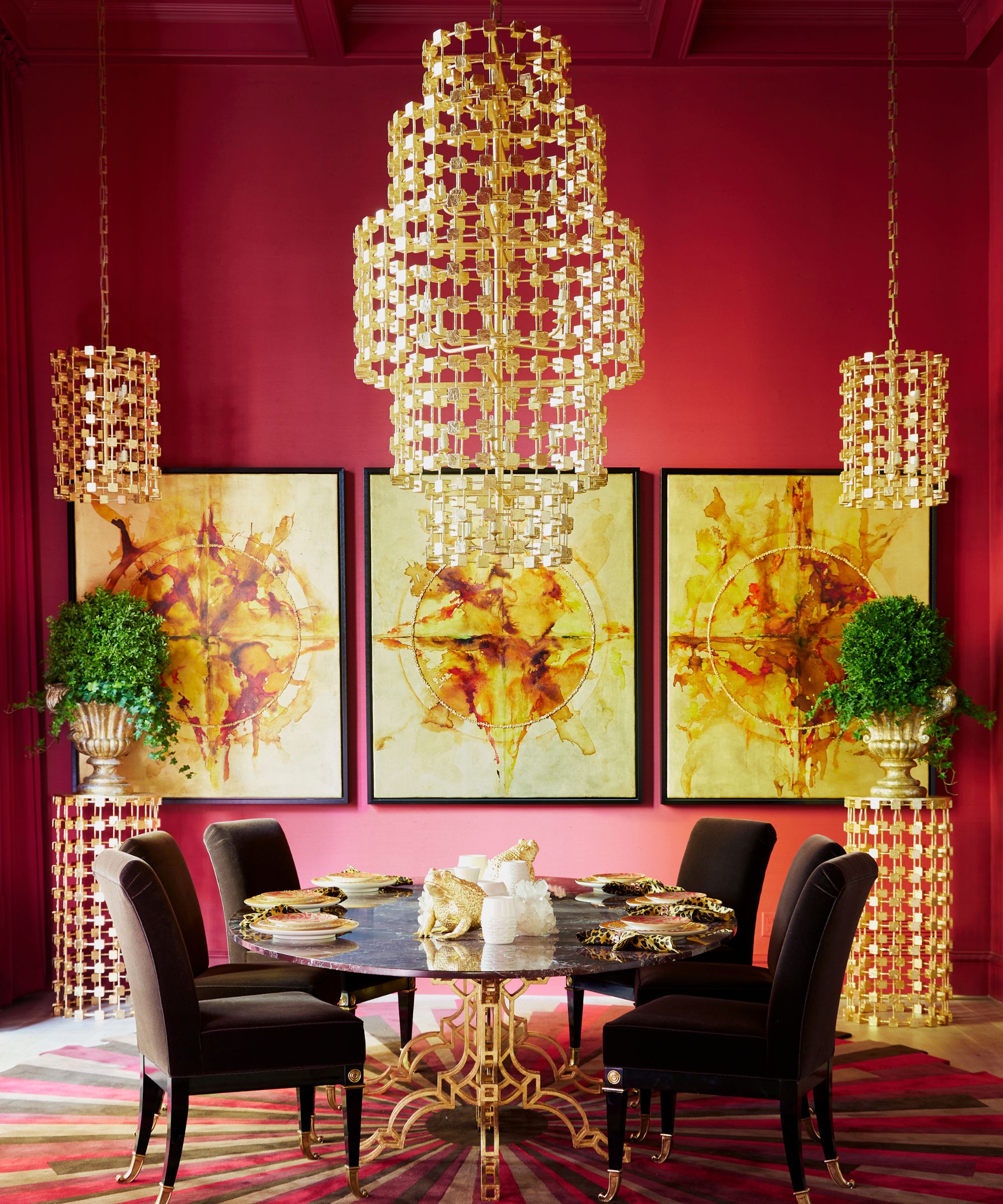7 designer-approved ways to decorate with red paint – guaranteed to make a statement
From dining rooms to kitchens, these are designers' favorite ways to use red paint


- 1. Embrace a vibrant red paint in small spaces
- 2. Choose a red paint to complement artwork
- 3. Create a playful look with a bold red paint
- 4. Opt for a terracotta shade in traditional schemes
- 5. Use a cherry red lacquer to reflect light
- 6. Decorate with red as a bold accent color
- 7. Channel a deep red paint in a dining room
Decorating with red paint can be a brave choice, but when done well, it can be one of the most impactful colors to use in home decor if you want to make a statement.
Vibrant shades of tomato red can energize spaces, whereas richer wine reds feel sophisticated and moody; color psychology is important to understand before decorating with red.
'In color psychology, red is incredibly stimulating and triggers a powerful physical response in the body, explains Tash Bradley, Head of Interior Design at Lick. 'It symbolizes excitement, courage, strength, energy, and warmth. When red is used in the right proportions, it really commands attention and makes an impact.'
Here, we've rounded up some of our favorite expert-approved ways to embrace this daring color trend, featuring the best red paints – from dining rooms to kitchens.
7 designer-approved ways to use red paint
From fully drenching a room in red paint for a truly maximalist scheme to using red more sparingly as an accent color, these red room ideas prove how impactful this on-trend paint color can be.
1. Embrace a vibrant red paint in small spaces

If you consider yourself a maximalist in your interior style, red can be one of the best colors to establish a bold look that sets the tone for the rest of the space. More specifically, highly saturated red paints bring energy and drama to a room, such as Sherwin-Williams' Energetic Orange which was used in this maximalist kitchen designed by Matthew Boland of MMB Studio.
While maximalist colors like this one may seem daunting to decorate with, Matthew says that bold colors can actually positively impact small rooms.
Design expertise in your inbox – from inspiring decorating ideas and beautiful celebrity homes to practical gardening advice and shopping round-ups.
'In this guest house the kitchen is compact so I wanted to make it a star,' says Matthew. 'The color literally grabs your attention and allows your eye to travel the entire length of the space. The smallest spaces can be the most memorable if you keep the focus strong.'
2. Choose a red paint to complement artwork

In this dining room designed by Los Angeles design studio STUDIO KEETA, Farrow & Ball's Preference Red is used in a semi-gloss finish on the walls and ceiling.
'The dining room is the first room that is seen off of the entry foyer,' explains the studio's founder and principal Kristina Khersonsky. 'The 1930s home has an open floor plan, in which every room is visible through each room’s open arches, so to break up the textured white walls, this deep Baroque-inspired red was the perfect focal point as the anchor to the house as well as an intentional way to break up the crisp white walls surrounding.'
This particular shade of red was also chosen to complement the artwork on display. 'Our client had art hung that she had painted in the room, in which the painting’s tones harmonized perfectly with Preference Red,' shares Kristina.
Additionally, opting for a semi-gloss finish maximizes natural light, and can be a good choice for rooms with limited daylight. Kristina adds that this was the case for this project: 'The gloss sheen was intentional to allow the light coming into the room to bounce off the walls and play up the natural light coming in.'
3. Create a playful look with a bold red paint

Decorating with a vibrant shade of red paint can work especially well in rooms you want to feel energetic and playful. While saturated reds certainly don't create a calming feel, they do bring warmth and energy, which can be a desired effect for social spaces.
Interior designer Kati Curtis of Kati Curtis Design demonstrates this in this Tudor family home, turning this room into a playroom for the client's young children. 'We custom designed the vibrant red hue, produced by Fine Paints of Europe to encourage playfulness,' explains Kati.
The paint is used across the walls, paneling, and window seats (created in collaboration with ART Architects) and is paired with plenty of bold patterns and statement fixtures to fully cement its maximalist decor style.
4. Opt for a terracotta shade in traditional schemes

Farrow & Ball's Book Room Red is a muted, dark shade of terracotta and was used across the walls in this traditional home office designed by NYC-based Bennett Leifer Interiors.
The design studio says that this paint color was chosen to complement all of the room's dark-toned woods and leather upholstery, enhancing its traditional decorating style. They add that the aim was to lean into a dark color scheme, rather than offsetting heavy furniture with a light paint, which ensures it has cozy appeal.
If you're looking for a red paint to use across the walls that doesn't feel jarring, Book Room Red is a great choice, and Farrow & Ball say that it's a particularly good color choice for small rooms.
5. Use a cherry red lacquer to reflect light

Deep shades of red can create a moody and sophisticated look when used across the walls in a room and can be much less stimulating than more vivid shades of this color.
Design studio Alice Lane Interior Design used a custom dark cherry red lacquer across the walls and built-in cabinetry in this formal library room, which is used for entertaining guests and also features a bar. While such an intense color could quickly feel too overpowering, the light-reflecting properties of the lacquer brighten the space, making it the perfect space for entertaining.
'We went with a cherry red lacquer,' explains designer Kristina Kellett. 'It reflects light and makes the space lighter, so it doesn’t feel like a cave.'
6. Decorate with red as a bold accent color

Decorating with red doesn't have to mean painting all four walls in a room. Since red can be incredibly intense when used in our homes, using it as an accent color can be a more liveable way to embrace this color trend.
Interior designer Matthew Williamson used red paint on the headboard in this maximalist bedroom and explains why he tends to use red in smaller doses in projects, very much embracing the unexpected red theory:
'Red is certainly not the easiest color to live with, but if you’re feeling brave and bold it can have a big impact. These days, I’ve moved on from red rooms and have evolved into a phase where I now see red as more of an accent color rather than for full room saturation.
'Instead of using it as a top-to-toe color, I now use it with restraint to highlight and draw attention to an accessory or an item of furniture that I particularly want to stand out. A single piece picked out in red can do wonders for a space. I always try to bear this in mind when putting together schemes for whole rooms, and rein in the voice in my head telling me to go full-throttle red.'
7. Channel a deep red paint in a dining room

In this grand dining room designed by interior design studio Fisher Weisman, Benjamin Moore's Umbria Red is used on the walls, creating a glamorous look when paired with the rest of the room's opulent fixtures.
'Red made the dining room feel like a destination, and it delivers a sense of intimacy and specialness,' says co-founder and designer Jeffry Weisman. 'The glamour of gold against red is timeless. Venetian red is our current obsession because of the drama and warmth it gives a space. The glow of the color draws you in and is happy. As a background, so many colors and materials stand out against it. We love the color in paint, in velvet, and in lacquer. It’s classic and modern.'
Additionally, the color psychology behind red shows that it is known to increase appetite, which makes it a particularly fitting dining room color choice.
From dining rooms to kitchens, most rooms in the home can handle red paint, albeit in varying amounts. While its intensity generally depends on how vibrant a hue you choose, make sure you don't overdo it in rooms where you want to feel calm. Painting a bedroom red can be overstimulating so it's best to channel this color trend as an accent in spaces such as these.

Emily is a freelance interior design writer based in Scotland. Prior to going freelance in the spring of 2025, Emily was Homes & Gardens’ Paint & Color Editor, covering all things color across interiors and home decor for the Homes & Gardens website. Having gained specific expertise in this area, Emily is well-versed in writing about the latest color trends and is passionate about helping homeowners understand the importance of color psychology in home design. Her own interior design style reflects the simplicity of mid-century design and she loves sourcing vintage furniture finds for her tenement flat.